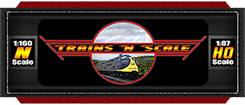 Loading... Please wait...
Loading... Please wait...-
Call us at: 941-500-2288
-
Mail Us at: Trains N Scale P.O. Box 178 Lehigh Acres, FL 33970-0178
- My Account
- Items / $0.00
All prices are in All prices are in USD
Categories
- Home
- Models and Prototypes Blog
- What is N Scale?
What is N Scale?
Posted by Neville C. Wilson on 15th Jun 2017
Although it may mistakenly be called N Gauge, derived from some of the earliest mass produced 1:152 "OOO" or "Treble-O" scale models manufactured by the British firm, Lone Star, in 1961, 9 mm wide (i.e., a track gauge of 0.354 inches, as measured between the inner sides of the rail) contemporary N Scale model production was initiated by the German firm Arnold Rapido in 1962.
Referencing its track gauge of nine millimeters, the designation "N" is short for nine.
By 1964, long before the advent of operating knuckle couplers in N Scale, Arnold locomotives and rolling-stock came equipped with the now pervasive hook style Rapido coupler; which was made available to other manufacturing firms, further aiding a rather rapid expansion in model production.
Though it was possible to use a hands free approach to uncoupling early Rapido coupler equipped Kadee Micro-Trains models by utilizing an included pair of small magnets (which were packed with early production car releases), along with an electromagnet, or stationary magnet that was placed below or between the track rails, the short pin like protrusion that is commonly found on the bottom of Rapido couplers also made it possible to automatically uncouple Rapido style couplers with a track section that is fitted with an electromagnetically operated platform, which is positioned between the rails.
The aforementioned platform rises when the electromagnet is activated, which in turn, via the pins, pushes the couplers into a raised position, thereby uncoupling them.
While various knuckle coupler designs are now commonly used in North America and Australia, reliable and inexpensive to fabricate, Rapido couplers are still a universal standard in Europe.
Though a rail width of 9 mm remains constant for standard gauge (as opposed to narrow gauge) N Scale locomotives and rolling stock, depending upon the place of manufacture and/or the specific market that a model is targeted to be sold in, its size in proportion to its prototype (i.e., "scale") may be 1:148 (British), 1:150 (for Japanese 3 foot 6 inch /1,067 mm or 4 foot 6 inch / 1,372 mm gauge trains), or 1:160 (for North American, Japanese 1,435 mm high-speed trains, and European) scale.
HO Scale modelers often utilize readily available N Scale (9 mm/0.354 inch) track to model two foot six inch narrow gauge HOn30 (NMRA) or HOn2½ and HOe (NEM) lines.
In N, commercially manufactured Z-Scale (6.5 mm/0.256 inch) track products are frequently used when modeling three foot narrow gauge Nn3 railway systems.

How standard gauge Z, N, HO, and O Scale Model Train Locomotives Compare In Size
As is the case with prototype railways, N Scale manufacturers produce rail in different heights.
Expressed in thousandths of an inch, track "Code" refers to the measured height of manufactured model rail.
Extremely popular and approximately 50 percent larger than heaviest prototype Code 155 main line rail used by the Pennsylvania Railroad, Code 80 (0.080-inches tall or about 12 scale inches high) track has been the industry standard for many years.
Typically designed for modelers seeking products that are closer to scale, manufacturers also produce track in Code 70 (0.070 inches tall, which represents 11.2 scale inch high rail that is approximately 40 percent larger than heaviest prototype Code 155 main line rail used by the Pennsylvania Railroad), Code 55 (0.055 inches tall, which represents 8.8 scale inch high rail that is approximately 10 percent larger than heaviest prototype Code 155 main line rail used by the Pennsylvania Railroad), and Code 40 (0.040-inches tall, which represents 6.4 scale inch high main line 107 pound per yard rail).
There are several caveats to consider when adopting more scale-like rail:
1. Older N Scale models may need to have their wheels and/or wheel-sets modified or replaced because of the height of the factory supplied wheel flanges, which will often hit the top of the simulated spike heads that secure the low profile rails to their ties or sleepers. Retrofitting rolling-stock with aftermarket low-profile wheel-sets is fairly easy, and can usually be done at moderate cost
2. Though the tolerances of wheels and wheel-sets should be checked before newly acquired models are initially run, closer attention must be paid to wheel gauge and flange heights whenever low-profile rail is utilized.
3. With regards to North American style N Scale track, there is presently a somewhat limited range of prefabricated products available in anything other than Code 80.
Although 1:144 scale plastic model aircraft, armor, structures, and vehicles can be found on N Scale dioramas, layouts, and modules, these products are larger than any of the established proportions for British, European, Japanese, and North American N Scale railway models.
With a large global following that is second only to that of HO Scale, because of its diminutive size, N Scale is the most popular choice for railway models in Japan, where available space is typically limited.
Where space is not a major concern, it is the ability to model expansive scenes and large train consists that appeals to many N Scale modelers.
View additional articles like this one in the Trains N Scale™ Models and Prototypes Blog.
Recent Posts
- » A Quick Look: Intermountain Fox Valley Red Caboose Autoracks Review
- » A Quick Look: Athearn 2293 N UPS Wedge Trailers and Dolly
- » A Quick Look: Atlas N 1993 Ford Explorer SUV 5th Run Review
- » A Quick Look: Eastern Seaboard Models N Metal Wheel-Sets Review
- » A Quick Look: Jacksonville Terminal JTC NSC 53' Well Cars Review
